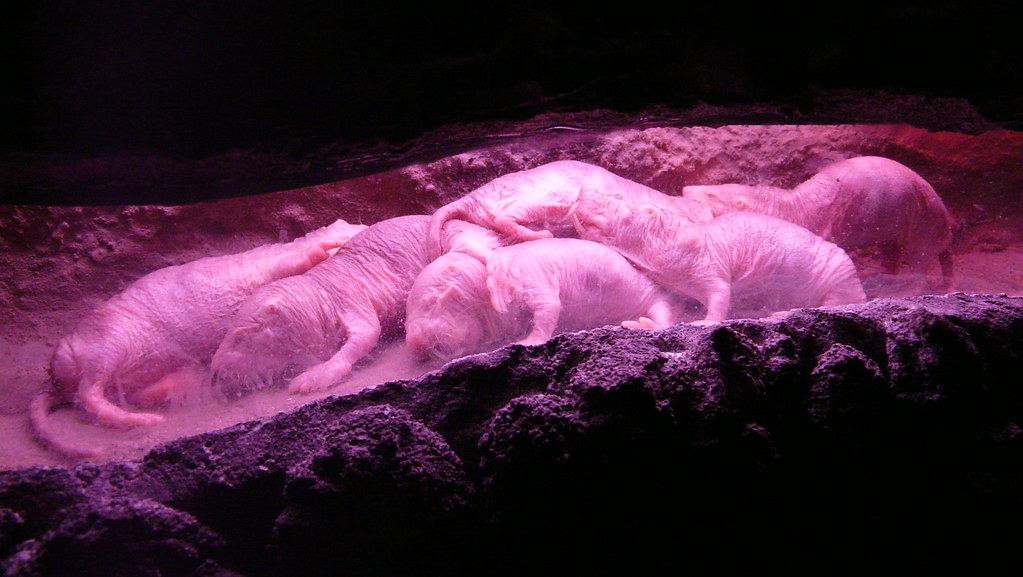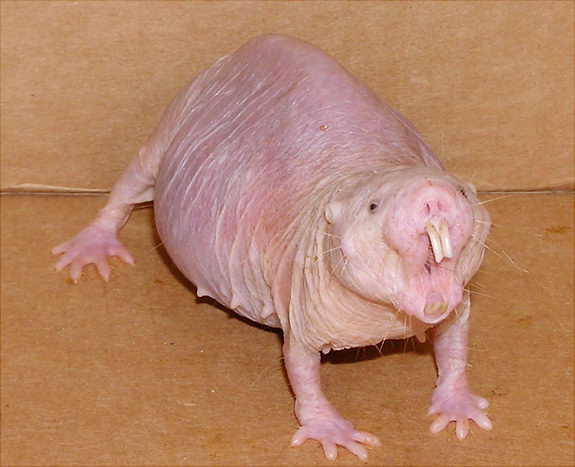Rodent Superhero
The naked mole rat (Heterocephalus glaber) is extraordinary in many traits. It's unlikely to get cancer, it can live longer than any other rodent, it's operatively poikilothermic, it can run backwards just as efficiently as it runs forwards, and it's eusocial.
These are some badass claims, now let's get some evidence about its "superpowers".
H. glaber deals with hypoxia remarkably.
If you're unfamiliar with any words, see the vocabulary below the article.
Cancer Resistance
There are several mechanisms that make this species cancer resistant. Scientists from the Department of Physiology and Barshop Institute for Longevity and Ageing Studies at the University of Texas, San Antionio, conducted a study in which they in vivo transduced H. glaber fibroblasts with SV40 TAg and Ras. These oncoproteins play a huge part in malignant tumor growth in humans and mice. After the H. glaber cells were transplanted into immunodeficient mice, the researchers observed that the cells quickly entered telomere crisis - a mechanism that suppresses tumor growth and normally leads to cell death. The same could not be said about mouse cells.
How did H. glaber avoid cancer?
Their fibroblasts secrete extreme high-molecular-mass hyaluronan, which is said to be more than five times larger in naked mole rats than in cancer-prone humans and laboratory animals. Their ribosomes produce "perfect" proteins - they're basically error-free. Also, they make use of the "over-crowding" genes p15 and p16 that stop cell division once separate cells come into contact, a mechanism called contact inhibition. A 2014 study found a hybrid of the two genes in the animals, which may additinally contribute to their tumor-resistance.
This does not mean they cannot get cancer at all.
Knowing that the human telomerase reverse transcriptase (hTERT) helps cells avoid telomere crisis and allows further cell division, the researchers at the University of Texas, San Antionio, re-infected the SV40 TAg- and Ras-transduced H. glaber cells with an hTERT-coding retrovirus and learned that even though H. glaber and humans are unrelated, hTERT helped the naked mole rat cells avoid crisis and did indeed cause malignant tumor growth. The first study to confirm cancer in zoo-housed H. glaber was published in 2016.
The species is highly resistant, but not completely so.
Longevity
Living a life about ten times longer than other rodents of the same size makes the naked mole rat the longest living rodent! It lives for up to 30-31 years! Some scientists say it "lives its life in pulses" since it can reduce its metabolism to a large extent when life gets tough, and it can prevent damage from oxidative stress. The composition of membrane phospholipids may minimize oxidative damage and thus contribute to longevity.
Poikilothermy
When you look at the naked mole rat, you could ask yourself: isn't it cold? In its natural habitat, it isn't. But you're right to suggest that this guy could have some issues with thermoregulation. According to Daly and Buffenstein (1998), the species exhibits signs of poikilothermy: its skin lacks an insulating layer and has pigment-containing cells in the dermis, rather than in the epidermis, which is more typical for homeotherms. It, as you may see, lacks fur, but has a thicker epidermis and few sweat glands. And they truly respond to changes in ambient temperature like poikilotherms. They are endothermic, but they aren't homeotherms.
If they don't move around, they huddle (see image below), which doesn't only save energy and water, it also helps them keep their body temperature somewhat stable. It seems that low concentrations of the thyroid hormone make this strategy possible for the naked mole rat.

Photo credit: Javier Ábalos
'Palindromic' Runners
Naked mole rats can run backwards just as fast as they run forwards thanks to their short legs. They use their whiskers to navigate in the tunnels. As they run, they move their head side-to-side to maintain contact with the tunnel. If they run backwards, they do the same, only with their tail.
Truly remarkable, naked mole rats are exciting animals to study as they teach us a lot about breaking boundaries.
| In vitro: | 'In the glass' - also called 'test-tube experiments', such experiments are done in test-tubes, on Petri dishes, microtiter plates, etc. |
| In vivo: | Such experiments are done on living organisms,
as the translation of the phrase - 'in the living' - suggests. |
| Fibroblasts: | The most common cell type of animal connective tissue. |
| SV40 TAg: | An oncoprotein encoded by simian virus 40, causing malignant changes in cells. |
| Ras: | Oncogenic mutations of these proteins can be found in ca. 20% of human cancers. |
| hTERT: | Its overexpression or mutation causes endless self-renewal leading to cancer. |
| Oxidative stress: | Imbalance between the production of free radicals and antioxidant defenses leading to tissue damage. |
| Phospholipids: | Molecules with hydrophilic phosphate heads and hydrophobic lipid tails, imporant components of every cell membrane. |
| Poikilothermy: | A quality that's characterized by having a fluctuating body temperature which changes in regard to the ambient environmental temperature. |
| Hyaluronan: | A polysaccharide located in the extracellular matrix, synthesized in the plasma membrane of fibroblasts. |

Photo credit: Jedimentat44
| Common name: | Naked mole rat |
| Scientific name: | Heterocephalus glaber |
| Phylum: | Chordata |
| Class: | Mammalia |
| Order: | Rodentia |
| Family: | Heterocephalidae |
| IUCN status: | Least concern |
| Population trend: | Stable |
| Scientific reading: |